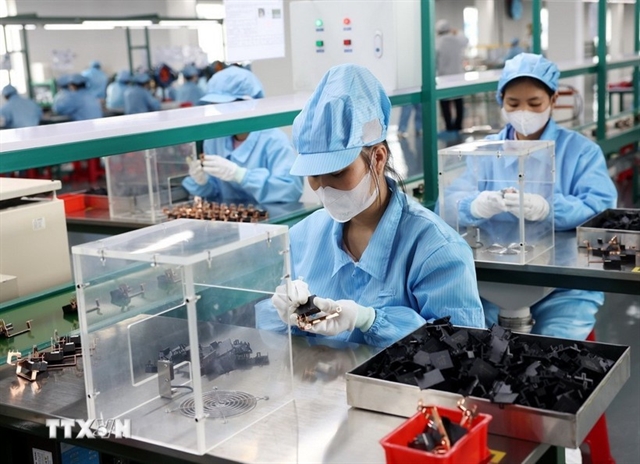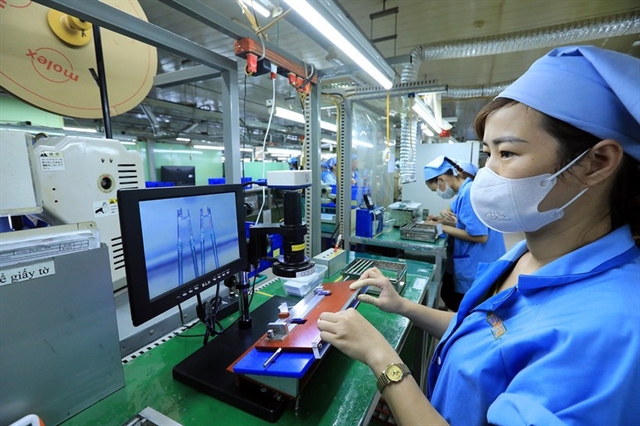 Society
Society

Nearly 150,000 people are diagnosed with cancer annually in Việt Nam, and experts predict the disease will affect more and more young people.
 |
| A doctor at HCM City Oncological Hospital treats a child cancer patient. Nearly 150,000 people are diagnosed with cancer annually in Việt Nam, and experts predict the disease will affect more and more young people. — VNA/VNS Photo Phương Vy |
by Mai Khuyên
The Creator endows humans a life to live, but also sets a deadline for life to come to an end. Nothing or no one can defy nature, but it is unbearable that in just a week, I had to say goodbye forever to two of my loved ones and received bad news that another is going to die.
All of them were young. The youngest was just 21 and the oldest was 54, and they were both victims of cancer – a nightmare for all generations, and a disease in which science seems to find no weapon to fight.
Trần Văn Trung, the youngest, was a student at the Polytechnic University. He died this year of blood cancer while still finishing his school year.
The young man was the pride and joy of his mother, a single mom, because he embodied the talent and intelligence of an active and honest man.
Trung died at an age that population experts consider a ’golden age’ for the workforce. He died without knowing why he had to, leaving behind his dreams of becoming a technician, getting married and having many children.
Lê Văn Sáu, 43, another patient from Thái Bình Province, died just 20 days after he was diagnosed with liver cancer. In a way, Sáu, is luckier than Trung because he had the chance to have a wife and two children. Sáu was the main supporter of his family, so he still had much work to do had he survived.
The man was hardworking, experienced, tough but honest, and particularly devoted to his work as a police officer in Hà Nội.
The last one, Nguyễn Hữu Tiêm, 54, a high-ranking official at the State Bank of Việt Nam, was diagnosed with rectum cancer in June and is now still struggling with the disease while following strict therapy and lifestyle changes. As the luckiest patient of cancer, Tiêm discovered symptoms at an early stage and adapted well to drugs.
Nearly 150,000 people are diagnosed with cancer annually in Việt Nam, and experts predict the disease will affect more and more young people. A recent report from the Ministry of Health stated that 75,000 die from the disease every year, and Việt Nam has one of the highest rates of cancer patients in Asia.
Moreover, he shows an optimistic determination to fight against the disease, so everything seems to be going well for him so far.
Tiêm hoped he would have more time - at least five years to do all he can to overcome the disease.
The three men were among nearly 150,000 people diagnosed with cancer in Việt Nam every year, and experts predict the disease will affect more and more young people.
A recent report from the Ministry of Health stated that 75,000 die from the disease every year, and the country has one of the highest rates of cancer patients in Asia.
Many experts said cancer is caused by unhealthy lifestyle choices, such as alcohol addiction or avoiding exercise.
But the three aforementioned patients did not have bad habits, were not addicted to alcohol and did not smoke. They were all educated and followed a healthy lifestyle.
So what caused their diseases?
Trung was a student and had never been addicted to smoking or drinking. The doctor suspected that the young boy may have been poisoned by some unnatural preservative substance in instant noodles, which he often ate for his meals. As a poor student, Trung did not have much financial support, except for his mother, who could only provide a meager sum for his studies. The student used to save as much as possible to live in the city. The mother said that sometimes he had to eat instant noodles the whole week to survive.
Sáu once contracted Hepatitis C, but was cured 10 years before his death. Through his daily routine record provided by his wife, doctors found that the man used to be in favour of salty dishes and, moreover, he was rather careless and neglected to protect his liver, and contracted hepatitis B as a result.
Doctors also pointed to some unnatural poisonous chemical substances that had helped intensify the disease, as all of the three patients had a common habit of eating out.
Experts at a conference held by the Ministry of Health in March noted that 80 per cent of cancer cases in Việt Nam were attributed to outside factors, such as air pollution, unsafe food and toxic work environments with unsafe food.
In particular, agents from unsafe food took the lead among carcinogenic factors, accounting for about 35 per cent of cases, while genetic factors account for only 5-10 per cent, the conference reported.
Experts also predicted the number of annual cases to rise to 189,000 by 2020.
Recent statistics from Hospital K in Hà Nội, which specialises in cancer treatment, showed the hospital received more than 1,000 patients for medical checks-up a day, up from some 700-800 patients five years ago.
A report by Bạch Mai Hospital in Hà Nội also revealed that more than 73 per cent of cancer patients in Việt Nam die every year, compared to the average rate of 59.7 per cent worldwide, making Việt Nam one of the worst countries in the world in terms of cancer death rates.
Hospital Deputy Director Mai Trọng Khoa was quoted by the online Dtinews as saying that more young people have become cancer victims, including those in their twenties and children.
Dr Nguyễn Bá Đức, deputy chairman of the Việt Nam Cancer Association, said three factors affect cancer, including genetics, pollution and diet.
Việt Nam has six big hospitals for tumour treatment and 50 specialised faculties in hospitals at district levels, yet they are able to meet only 70 per cent of the demand. Worse yet, two leading hospitals, including K Hospital in Hà Nội and Tumor Hospital in HCM City, are always overloaded. The country is looking forward to expanding and building more satellite hospitals. — VNS




